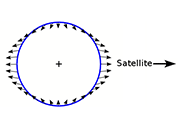E-Archive
Off the Beaten Track
in Vol. 14 - September Issue - Year 2013
Go with the Flow

A Tidal Stream Generator

Tides created by Moons gravity
The global petroleum crisis of the 1970’s provoked a renewed interest in alternative sources of energy. Economists and politicians realized that the world economy had become too dependent on fossil fuels for its energy needs. Scientists and ordinary citizens were getting more and more concerned about the negative impact that the use of these fuels was having on the environment. At the same time, the consumption of fossil fuels was beginning to skyrocket, with more and more cars on the roads and more heating systems being installed. Something had to be done.
Among the various ideas that were being tossed around at that time, much attention was focused on the so-called renewable sources of energy, capable of generating power without depleting Earth’s natural resources and without polluting air and water. Research and investments in new types of generators, especially those powered by the sun and by the wind, grew exponentially. The one big drawback with these alternatives was their very low energy yield, which made them too expensive and uneconomical to be applied on an industrial basis.
However, there was another type of alternative energy source that had been in use for many years before that period in our recent history. This was tidal power.
The gravitational force of the Moon on Earth’s oceans and seas causes tides. To a lesser extent, the Sun’s gravity also plays a part. The Moon’s gravity causes water levels to rise in those oceans that are facing and diametrically opposite the Moon. The extent to which tides rise and fall at any given point also depends on the Earth’s rotation and on the configuration of the coastline and on the depth of the sea in that area. On the Atlantic Ocean, significant tidal ranges can be found in northwestern France, the northern part of the British Isles and in Canada, where the highest tidal ranges in the world are recorded at Fundy Bay, in Nova Scotia, with a differential of over sixteen meters.
Tidal power converts the energy of tides into other useful forms of power, mostly electricity. The one big advantage over other types of renewable energy is that tidal power is predictable and much more constant. However, until recent years, power had been generated with the tidal barrage method. This method has historically suffered from two big drawbacks: the high initial cost of structures and the scarcity of sites with adequate tidal ranges. In fact, traditional tidal power plants had to be located on tidal estuaries with the required characteristics, i.e. on the mouths of rivers far away enough from the effect of waves but close enough to the sea to have adequate tidal ranges. In addition, the construction of dams to block the entire width of river estuaries required high capital investments.
The world’s first tidal power station was inaugurated in November 1966 on the Rance River, in Brittany, France. It has an installed capacity of 240 MW and generates 600 GWh on an annual basis. There are 24 turbines placed on a 750-meter long dam, which creates a tidal basin of over 22 square kilometers. The tidal range is about 8 meters.
New plant designs and new turbine technology have opened exciting new prospects. The tidal stream generator method works with submerged turbines attached to either floating supports or to structures fixed on the seabed. This method generates energy with moving masses of water in much the same way that wind turbines generate energy with the wind. Tidal stream generators are relatively cheap to build and have a minimal impact on the environment, since actual mechanical parts are relatively small and the method does not require the construction of dams. The technology is still relatively young and different types of turbines are being proposed and tested on a regular basis. The European Marine Energy Centre has classified six basic types of tidal stream generators according to the different types of energy converters: horizontal axis turbines, vertical axis turbines, oscillating hydrofoils, venturi devices, Archimedes screw and tidal kites. The only commercial scale tidal stream generator currently in use is located in Strangford Loch, Northern Ireland. It has two axial flow turbines, each of which attached to a separate generator, and can generate electricity on both the ebb and flood tides. Its installed capacity is 1.2 MW and it now feeds about 1 GWh per year into the local grid.
Not much when compared to traditional forms of energy generation, but the technology is improving and the yield is rising day by day. Who knows what the future will bring?
By Giovanni Gregorat, Contributing Editor MFN
Author: Giovanni Gregorat



























